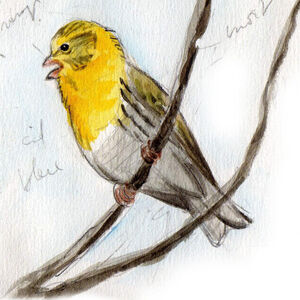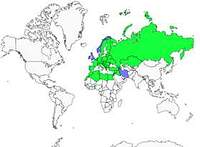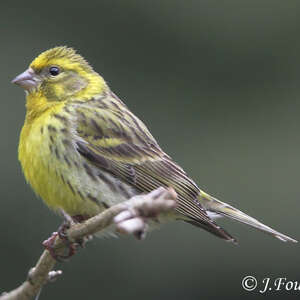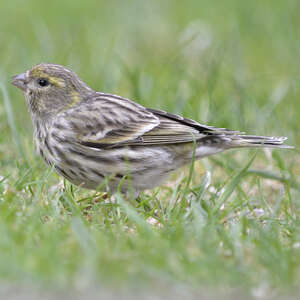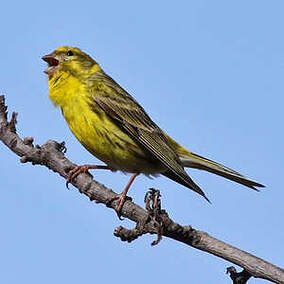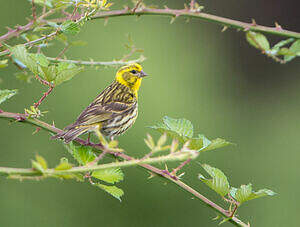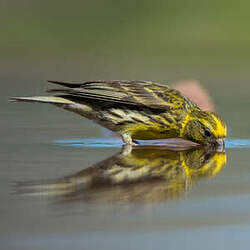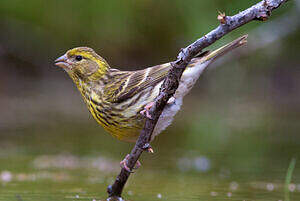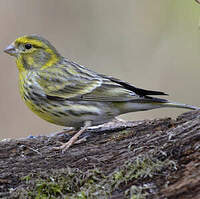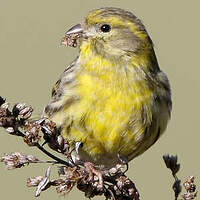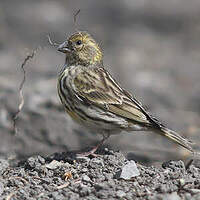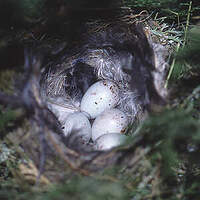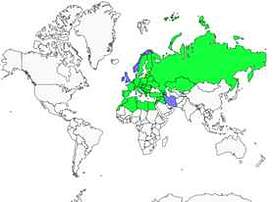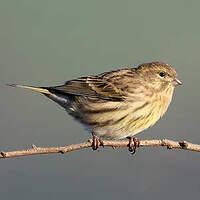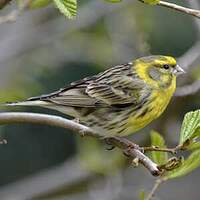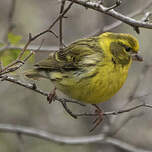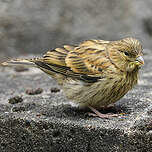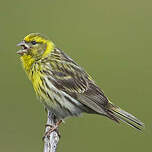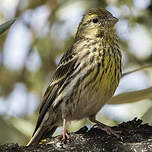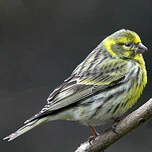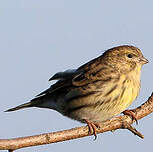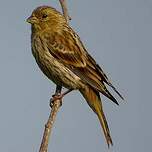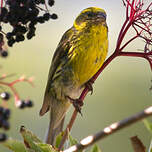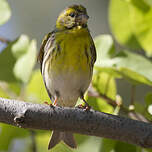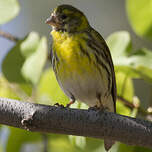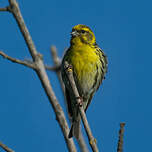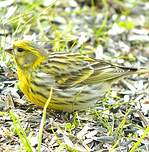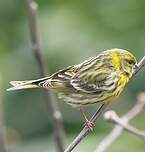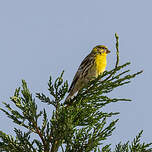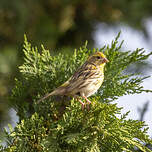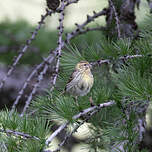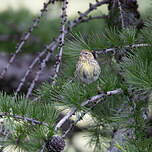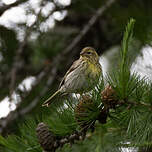European Serin
Serinus serinus - Serin cini
Identification
The European Serin is the smallest of the European Fringillidae. It has a large head with a thick beak, a relatively compact body and a rather short tail. The species is monotypic. The adult male can be recognized by the bright yellow of its plumage, especially at the front of the body, on its head and chest. The yellow of the rump is really only visible in flight. The head pattern is typical with bright yellow on the forehead, the ear area and the throat, the back of the crown, the nape, the parotoids, the malar stripes being more or less dark, of a beige grey shaded with olive. The small, obtuse beak, pink to brownish, accentuates the big head impression. Often the small, dark eye is outlined by a whitish crescent and the mustacian space reduced to a yellow spot. The mantle and scapulars are grey-beige, clearly striped longitudinally in brown. The feathers on the wings and tail are blackish brown, but with clear edgings or whitish fringes that break up the uniformity. The whitish tips of the greater and median coverts form two wingbars, whitish to yellow depending on the individual. The flanks are white, with blackish stripes that can be arranged in longitudinal lines. All body parts that are not bright yellow can be washed with yellow to varying degrees according to the individuals. The small legs are pinkish. The adult female is similar to the male, but much duller, without the bright yellow of the latter's plumage. The yellowest part of the body is the rump, but it is hidden when perched. On the other hand, it becomes diagnostic of the species in flight. The head pattern is that of the male, but attenuated. The entire plumage can be washed with yellowish green or not. The female is also clearly striped, above and below. The juvenile can be distinguished by its warmer, browner new plumage than that of the female.The chamois invades the upper parts clearly striped with brownish colour. The two reddish wingbars are well visible. The rump is pale brown. The underside is also warmer, tinted with reddish yellow and striped. To avoid confusion with other young finches, young linotic for example, it is necessary to take a good look at the morphology of the beak.
Subspecific information monotypic species
Foreign names
- Serin cini,
- Serín verdecillo,
- milheirinha-europeia,
- Girlitz,
- csicsörke,
- Europese Kanarie,
- Verzellino,
- gulhämpling,
- Gulirisk,
- kanárik poľný,
- zvonohlík zahradní,
- Gulirisk,
- keltahemppo,
- gafarró europeu,
- Gulfinka,
- kulczyk (zwyczajny),
- ģirlicis,
- grilček,
- Канареечный вьюрок,
- セリン,
- 欧洲丝雀,
- gulhämpling,
- 金黃絲雀,
Voice song and call
The song of the European Serin is typical and diagnostic. It is a fast and liquid chirping, composed of high-toned notes that often follow each other without interruption for several tens of seconds. It is difficult to translate the notes that make it up, it is the whole that makes it typical. It could be compared to the song of the Common Chiffchaff, for example, but that of the Serin is of higher pitch and has a more metallic timbre. It is emitted either from a high singing post (tree top, electric wire, television antenna, etc.) or during the nuptial flight. The flight cry is a liquid trill, made up of quickly strung notes close to the trill, which could be translated by pti li li li li li. It is somewhat reminiscent of the rolled cry of the Great Tit, but with a much higher pitch. The contact cry is a tillit or tillillit, which sounds like a small bell. There are also stretched and nasal ssuuii reminiscent of the Common Chiffchaff's cry. The specific name cini probably refers to its voice.
Habitat
European Serin is a plains or mountain bird, with southern inclinations, and therefore enjoys a good amount of sunshine.
Behaviour character trait
The European Serin is a partial migrant, returning to its breeding sites quite early in season, late March to early April in France for example.
Its migration is heralded by its typical crackling song, marking that the beautiful days are here. Males are the first to establish their territories back. As soon as females arrive, they are inundated by their partners, all yellow-clad, religiously chasing them with their singing, swaying nuptial flights, and body gestures (posture erect, wings drooping, tail elevated, throat feathers bristling). As soon as the courtship is over, the pair start reproduction without delay. It is territorial and looks to preserve its privacy from other members of the species, but in very favorable places, it can form loose colonies. It is a quite unassuming bird, often quite at ease in presence of humans. If you have a garden, you can foster for the species by planting dense, evergreen shrubs like box or small ornamental conifers where it carries its nest, and by preserving some "weeds" in your vegetable garden with the cores being its delight. Southern birds are sedentary. Northern birds do their migration quite late, in September / October. During migration tracking, one can then spot them in dispersed small groups heading south for the winter. The species is not known to frequent feeders and other artificial feeding points, like some of its cousins.Flight
The flight is typically fringillid, direct and undulating. The small size, compact silhouette and trilled calls are then good identifiers. The nuptial flight is particular and reminds that of the greenfinch. It is a fluttering flight, with slow and broad beats, accompanied by a typical chirping song.
Dietfeeding habits
Reproduction nesting
The European Serin's breeding season generally runs from February to August, but more specifically from April to July in temperate Europe.
The female builds the nest alone and the male only accompanies her during her movements, as is the case with most finches. The nest is a small cup constructed in a fork of a tree or bushy tree with dense, leafy foliage or better yet coniferous foliage. It is well fashioned, compact, and made of finely woven vegetable elements, moss, and is lined with fur and feathers. It typically lays 3 or 4 bluish-white eggs, lightly speckled with brown, and is incubated solely by the female for 12 to 13 days. The young are fed in the nest by both adults for 2 weeks and then after fledging for another 10 days. Chicks are easily recognized as they have loud, insistent begging calls pursing their parents for food. They are fed tiny, softened seeds regurgitated from the adult's gular pouch. A second clutch is typical in the southern portion of its range.Geographic range
The European Serin's breeding range extends across the west of the Eurasian continent and the Maghreb to Ukraine and Turkey to the east, in temperate and Mediterranean biomes. It is very continental to the north, leaving the British Isles and Scandinavian Peninsula for climatic reasons. On the other hand, to the south, all the Mediterranean islands are occupied. The species, partially migratory, overwinter in the southern part of the breeding range, the winter range spilling a little southward into the eastern Mediterranean. It can therefore be found in winter in northern Libya and Egypt (Nile Valley and Sinai) as well as in the Middle East where nesting remains very punctual.
Threats - protection
IUCN conservation status
concern
in the Wild
threatened
evaluated
The European Serin is a common, non-threatened species. Nevertheless, in a country such as France, the decline is real, as it is for many other species of birds and for reasons that are not well known. The STOC monitoring, a French program initiated by the Paris Museum, shows a 54% decrease in France's Serin population since 1989, which is enormous. Fortunately, if you can say that, the decline over the last 10 years (beginning in the 2000s) has only been -39%. The future of the species is thus locally uncertain.
Sources of information
- IOC World Bird List (v14.2), Gill, F and D Donsker (Eds). 2024-04-18.
- Monographie des Fringilles (Vol 3), Ottaviani Michel
- Les passereaux d'Europe, tome 2, P. Géroudet, M. Cuisin
- HBW Alive,
- Avibase, Lepage Denis
- xeno-canto, Sharing bird sounds from around the world,
Other sources of interest
 Specification sheet created on
15/07/2023 by Jean François
Specification sheet created on
15/07/2023 by Jean FrançoisTranslation by AI Oiseaux.net
© 1996-2025 Oiseaux.net
- Accipitriformes
- Aegotheliformes
- Anseriformes
- Apodiformes
- Apterygiformes
- Bucerotiformes
- Caprimulgiformes
- Cariamiformes
- Casuariiformes
- Charadriiformes
- Ciconiiformes
- Coliiformes
- Columbiformes
- Coraciiformes
- Cuculiformes
- Eurypygiformes
- Falconiformes
- Galliformes
- Gaviiformes
- Gruiformes
- Leptosomiformes
- Mesitornithiformes
- Musophagiformes
- Nyctibiiformes
- Opisthocomiformes
- Otidiformes
- Passeriformes
- Pelecaniformes
- Phaethontiformes
- Phoenicopteriformes
- Piciformes
- Podargiformes
- Podicipediformes
- Procellariiformes
- Psittaciformes
- Pterocliformes
- Rheiformes
- Sphenisciformes
- Steatornithiformes
- Strigiformes
- Struthioniformes
- Suliformes
- Tinamiformes
- Trogoniformes

